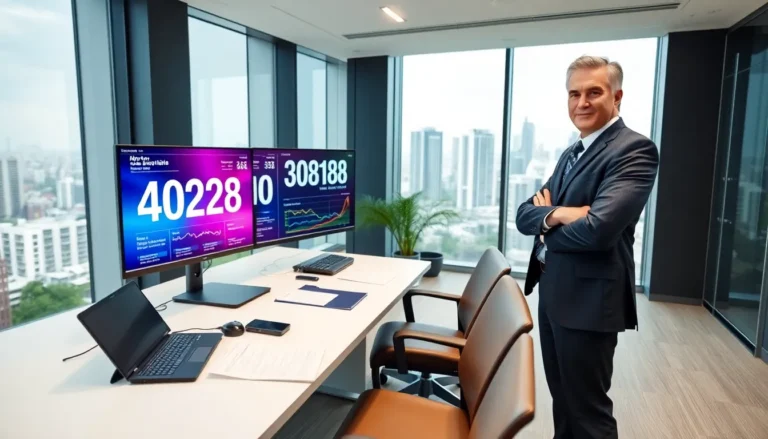Table of Contents
ToggleImagine this: you’re in the middle of a heated text conversation, your thumbs flying across the screen, and suddenly—bam! Your iPhone screen dims like it’s trying to take a nap. Frustrating, right? It’s like your phone’s saying, “Hey, I need a break!” But you don’t want your phone to snooze while you’re wide awake.
Understanding iPhone Screen Dimming
Screen dimming on an iPhone can disrupt user engagement during various tasks like texting. Recognizing the underlying reasons helps address this issue effectively.
Reasons for Screen Dimming
Automatic brightness adjustment reduces screen brightness based on ambient light. This feature activates when the device detects low light, leading to unexpected dimming. Additionally, power-saving settings activate after periods of inactivity. Users notice this particularly during active conversations. Heat can also trigger dimming; when the device becomes too warm, it conserves power by reducing brightness. Lastly, specific app settings may be configured to limit brightness for battery conservation.
Impact on User Experience
Dimming impacts how users interact with their devices. Frequent changes in brightness can lead to frustration, particularly during essential tasks like editing documents or taking calls. Limited visibility affects readability, making text challenging to see in certain lighting conditions. Disruptions can cause distractions, leading users to lose their trains of thought. Inconsistent screen brightness shifts attention away from engaging apps, reducing overall satisfaction. The experience of poor visibility can deter users from using their devices comfortably.
Adjusting Display Settings

Users can enhance their iPhone experience by adjusting specific display settings. These changes can prevent screen dimming during crucial moments.
Change Auto-Brightness Settings
Navigating to the Settings app allows users to find the Auto-Brightness feature. Disabling this option can stop the device from automatically dimming based on ambient light conditions. Users should locate Accessibility, then Display & Text Size, and toggle off Auto-Brightness. Turning off this feature keeps the screen consistently bright, making it easier to read text under various lighting conditions.
Modify Screen Timeout Duration
Adjusting the screen timeout setting provides another solution to dimming issues. Accessing Display & Brightness in the Settings app enables users to find the Auto-Lock option. Adjusting this timer to a longer duration ensures that the screen stays active while engaged in tasks. Selecting a longer interval, like five minutes, prevents unexpected screen dimming during important conversations or activities.
Enabling Low Power Mode
Activating Low Power Mode on an iPhone can contribute to screen brightness management. This mode reduces background activity, though it may slightly adjust the screen’s brightness as part of its energy-saving measures.
How Low Power Mode Affects Screen Brightness
Low Power Mode can reduce screen brightness to conserve battery life. Users may notice that their display appears dimmer when this mode is turned on. Adjustments prioritize saving energy over maintaining optimal brightness levels. Certain animations and background processes cease, contributing to a less distracting experience. If brightness is a primary concern during use, disabling Low Power Mode will restore maximum brightness.
When to Use Low Power Mode
Low Power Mode serves as an effective tool during prolonged usage when battery levels dip below 20 percent. Users benefit from activating this mode before heading out and relying on their device without access to a charger. It also aids in situations where users anticipate extended periods without charging opportunities, like during travel or long workdays. Employing this feature balances performance and battery longevity, proving useful in everyday scenarios.
Utilizing Night Shift and True Tone
Night Shift and True Tone enhance the iPhone display while directly affecting user comfort and visibility. These features adjust screen color temperature and help reduce eye strain, especially during prolonged usage.
Effects on Screen Visibility
Night Shift reduces blue light emission, which can help users read more comfortably in low-light environments. Users notice improved screen visibility during activities like reading or browsing at night. True Tone further optimizes the display by adapting colors to the ambient light, making text easier to read during the day. Enhanced clarity ensures that bright sunlight or dim settings do not compromise the viewing experience, effectively minimizing the frustration of unexpected dimming.
Maximizing Brightness While Using Features
Maximizing display brightness occurs even while enabling Night Shift and True Tone. Activating these features does not automatically lower brightness levels; instead, they simply adjust color warmth. Users can access the Control Center to manually increase brightness settings and maintain visibility during critical tasks. Adjusting these settings helps keep the iPhone screen at an optimal brightness level, ensuring that it stays bright and clear while enjoying various activities, such as gaming or video calls.
Other Tips and Tricks
Preventing your iPhone screen from dimming involves more than just adjusting settings. Several additional strategies enhance usability and comfort during device operation.
Keeping Your iPhone Updated
Regularly updating the iPhone ensures optimal performance. Apple consistently releases software updates that may address bugs related to screen brightness. Users who enable automatic updates simplify this process. Checking for updates manually involves navigating to Settings, selecting General, and tapping Software Update. Keeping the device up to date enhances overall functionality, including display features.
Restart Your Device Regularly
Restarting the iPhone can resolve minor glitches affecting screen behavior. A simple restart refreshes the device’s memory and may fix any software issues causing unwanted dimming. Users can restart their devices by holding the power button and sliding to power off. Incorporating a restart into a routine every few days can help maintain consistent performance. Regular device restarts contribute to smoother operation and less frustration during important tasks.
Keeping an iPhone screen from dimming enhances user experience during important tasks. By adjusting settings like Auto-Brightness and Auto-Lock duration users can maintain consistent brightness. Disabling Low Power Mode when necessary ensures visibility isn’t compromised for battery life.
Utilizing features like Night Shift and True Tone can also improve comfort without reducing brightness. Regular updates and device restarts further contribute to optimal performance. With these strategies in place users can enjoy uninterrupted conversations and activities, minimizing frustration and maximizing satisfaction with their device.




